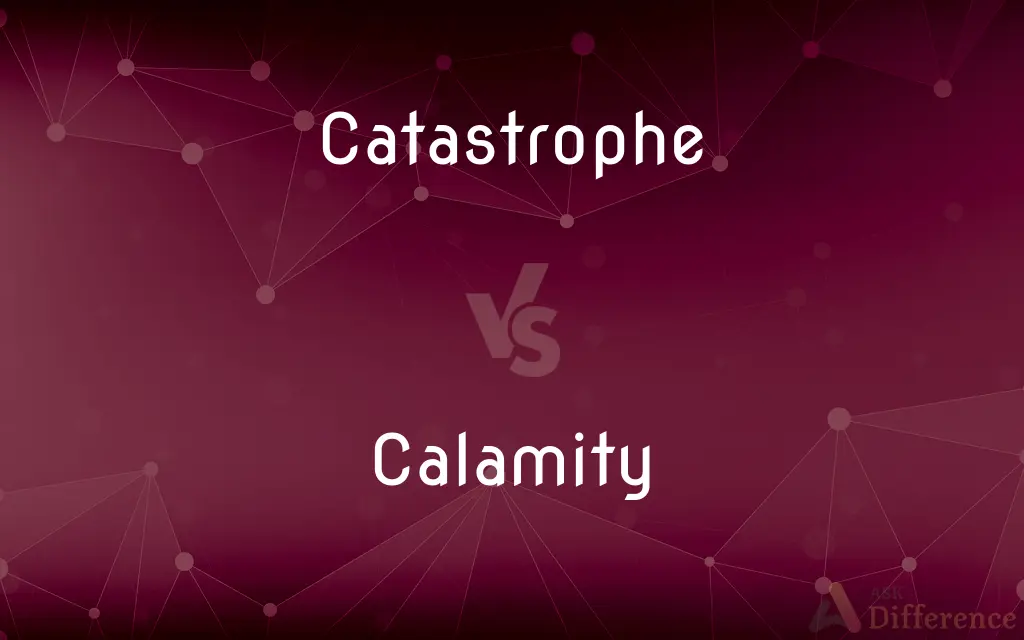Catastrophe vs. Calamity — What's the Difference?
Edited by Tayyaba Rehman — By Urooj Arif — Updated on March 30, 2024
Catastrophe is event causing great and often sudden damage or suffering, typically natural disaster or significant accident. Calamity is disastrous event marked by great loss and lasting distress and suffering, which can be either natural or man-made.

Difference Between Catastrophe and Calamity
Table of Contents
ADVERTISEMENT
Key Differences
Catastrophe often refers to large-scale disasters like earthquakes, tsunamis, or nuclear accidents, highlighting the extensive physical damage and immediate impact on life and property. It implies a suddenness and overwhelming scale that disrupts normal life significantly. Calamity, on the other hand, encompasses a wider range of disastrous events including wars, economic crises, and pandemics, in addition to natural disasters. It emphasizes the enduring hardship and suffering caused by such events, rather than just the immediate impact.
The term catastrophe is frequently used in insurance and risk management to describe events that cause significant damage, requiring substantial resources for recovery and rebuilding. Calamity is more often used in a broader context to reflect the severe effects on human welfare, social structures, and economic stability. While both terms denote serious events causing widespread harm, catastrophes are usually associated with abrupt physical destruction, whereas calamities also include the prolonged aftermath and recovery challenges.
Catastrophes highlight the need for emergency response and disaster preparedness to mitigate immediate damage, focusing on rescue, relief, and rehabilitation efforts. Calamities, conversely, draw attention to long-term recovery and support, addressing not only physical reconstruction but also psychological, social, and economic rehabilitation. The distinction between the two terms also lies in their scope of impact and the nature of their consequences, with catastrophes often being more sudden and calamities involving a broader, more enduring hardship.
In literature and media, catastrophes are depicted as pivotal moments that dramatically change the landscape, environment, or society, while calamities are portrayed through their lasting effects on communities, cultures, and individuals' lives. This distinction underlines the different aspects of disasters that society must address: the immediate physical destruction and the long-term recovery and resilience building against future adversities.
Comparison Chart
Definition
A sudden event causing great damage
A disastrous event causing lasting distress
ADVERTISEMENT
Examples
Earthquakes, tsunamis, nuclear accidents
Wars, economic crises, pandemics, natural disasters
Focus
Immediate impact and physical damage
Long-term suffering and recovery challenges
Use in Context
Often used in insurance and risk management
Broadly used to describe severe effects on human welfare
Associated Actions
Emergency response, rescue, relief
Long-term recovery, support, rehabilitation
Scope of Impact
Typically large-scale and sudden
Can include prolonged and enduring hardship
Compare with Definitions
Catastrophe
Often related to natural disasters.
The hurricane was a catastrophe, leaving thousands homeless.
Calamity
Can be natural or man-made.
The war brought calamity to the region, with lasting social and economic damage.
Catastrophe
Highlights the need for immediate response.
Catastrophe insurance helps cover the immense costs of disaster recovery.
Calamity
An event causing great and often prolonged distress.
The Great Depression was a calamity affecting millions worldwide.
Catastrophe
A sudden and large-scale disaster causing significant damage.
The Chernobyl disaster was a catastrophe with long-lasting environmental effects.
Calamity
Emphasizes enduring hardship and recovery.
Community support is crucial in overcoming the calamity and rebuilding lives.
Catastrophe
A great, often sudden calamity.
Calamity
An event resulting in great loss and misfortune;
The whole city was affected by the irremediable calamity
The earthquake was a disaster
Catastrophe
A complete failure; a fiasco
The food was cold, the guests quarreled—the whole dinner was a catastrophe.
Calamity
An event that brings terrible loss, lasting distress, or severe affliction; a disaster
A hurricane would be a calamity for this low-lying coastal region.
Catastrophe
The concluding action of a drama, especially a classical tragedy, following the climax and containing a resolution of the plot.
Calamity
Dire distress resulting from loss or tragedy.
Catastrophe
A sudden violent change in the earth's surface; a cataclysm.
Calamity
An event resulting in great loss.
Catastrophe
Any large and disastrous event of great significance.
Calamity
The distress that results from some disaster.
Catastrophe
(insurance) A disaster beyond expectations.
Calamity
Any great misfortune or cause of misery; - generally applied to events or disasters which produce extensive evil, either to communities or individuals.
Strokes of calamity that scathe and scorch the soul.
Catastrophe
(narratology) The dramatic event that initiates the resolution of the plot; the dénouement.
Catastrophe
(mathematics) A type of bifurcation, where a system shifts between two stable states.
Catastrophe
An event producing a subversion of the order or system of things; a final event, usually of a calamitous or disastrous nature; hence, sudden calamity; great misfortune.
The strange catastrophe of affairs now at London.
The most horrible and portentous catastrophe that nature ever yet saw.
Catastrophe
The final event in a romance or a dramatic piece; a denouement, as a death in a tragedy, or a marriage in a comedy.
Catastrophe
A violent and widely extended change in the surface of the earth, as, an elevation or subsidence of some part of it, effected by internal causes.
Catastrophe
An event resulting in great loss and misfortune;
The whole city was affected by the irremediable calamity
The earthquake was a disaster
Catastrophe
A state of extreme (usually irremediable) ruin and misfortune;
Lack of funds has resulted in a catastrophe for our school system
His policies were a disaster
Catastrophe
A sudden violent change in the earth's surface
Common Curiosities
How can the impact of a calamity be mitigated?
Mitigating the impact involves comprehensive planning, including economic support, psychological counseling, community rebuilding programs, and measures to strengthen social and infrastructure resilience.
How do societies prepare for catastrophes and calamities?
Societies prepare through disaster preparedness, emergency response plans, and long-term resilience and recovery strategies to address both immediate impacts and prolonged challenges.
Can a catastrophe also be a calamity?
Yes, a catastrophe can lead to a calamity if the disaster causes prolonged hardship and challenges in recovery.
Why is the distinction between catastrophe and calamity important?
Understanding the distinction helps in planning and allocating resources appropriately for emergency response and long-term recovery efforts.
What role do governments play in managing catastrophes and calamities?
Governments play a crucial role in emergency response, providing relief and support, enacting policies for recovery, and implementing strategies to prevent or minimize future disasters.
How do catastrophes affect insurance policies?
Catastrophes often lead to the reassessment of insurance policies, influencing premiums, coverage limits, and the development of specialized disaster insurance products.
What distinguishes a catastrophe from a calamity?
A catastrophe typically refers to a sudden, large-scale disaster, focusing on physical damage, while a calamity encompasses both immediate and long-term suffering across various dimensions.
What lessons have been learned from past calamities?
Past calamities teach the importance of preparedness, the value of strong community and social support networks, and the need for flexible, long-term recovery plans.
Can technological advancements help in predicting catastrophes?
Yes, technological advancements in fields like meteorology, seismology, and environmental science have improved the prediction and early warning systems for various catastrophes.
How do international organizations contribute to calamity recovery efforts?
International organizations provide crucial support through funding, expertise, and coordination of global relief efforts, helping affected regions recover and rebuild.
Share Your Discovery

Previous Comparison
Gravel vs. Sand
Next Comparison
Convey vs. ExpressAuthor Spotlight
Written by
Urooj ArifUrooj is a skilled content writer at Ask Difference, known for her exceptional ability to simplify complex topics into engaging and informative content. With a passion for research and a flair for clear, concise writing, she consistently delivers articles that resonate with our diverse audience.
Edited by
Tayyaba RehmanTayyaba Rehman is a distinguished writer, currently serving as a primary contributor to askdifference.com. As a researcher in semantics and etymology, Tayyaba's passion for the complexity of languages and their distinctions has found a perfect home on the platform. Tayyaba delves into the intricacies of language, distinguishing between commonly confused words and phrases, thereby providing clarity for readers worldwide.














































